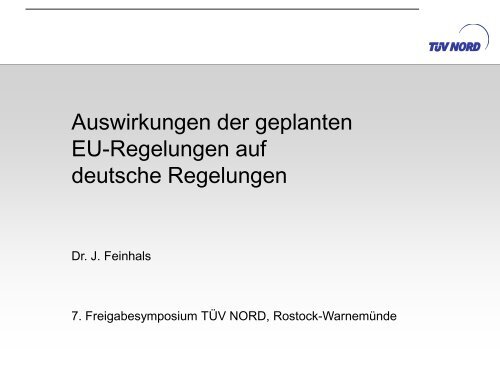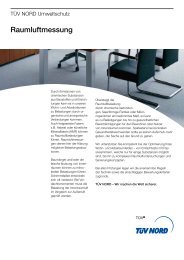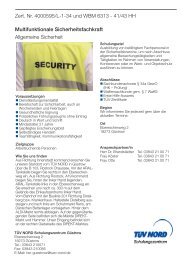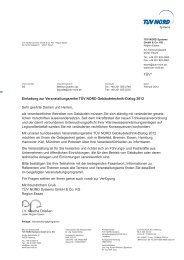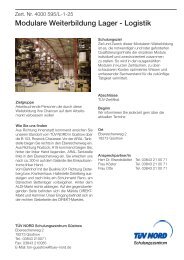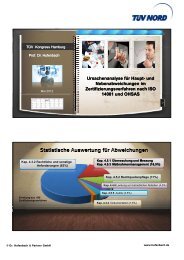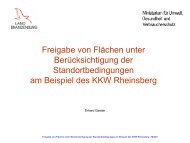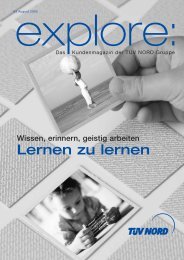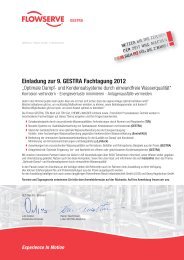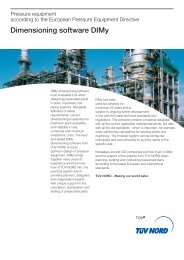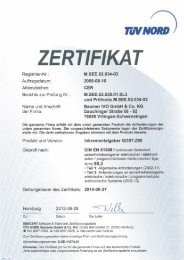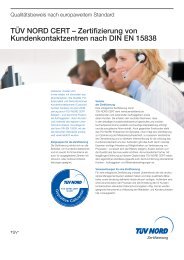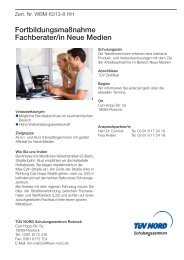Comparison of European Clearance values with IAEA RS-G-1.7 ...
Comparison of European Clearance values with IAEA RS-G-1.7 ...
Comparison of European Clearance values with IAEA RS-G-1.7 ...
You also want an ePaper? Increase the reach of your titles
YUMPU automatically turns print PDFs into web optimized ePapers that Google loves.
Auswirkungen der geplanten<br />
EU-Regelungen auf<br />
deutsche Regelungen<br />
Dr. J. Feinhals<br />
7. Freigabesymposium TÜV NORD, Rostock-Warnemünde
Auswirkungen der geplanten EU-Regelungen auf<br />
deutsche Regelungen<br />
Geplante Änderungen bei den Grundnormen der<br />
<strong>IAEA</strong> und EURATOM<br />
Was bedeutet dies für die Regelungen der<br />
Strahlenschutzverordnung?
Where to go? Outlook towards new international regulations<br />
Revision <strong>of</strong> the International Basic Safety Standards<br />
for Radiation Protection by <strong>IAEA</strong><br />
3
Where to go? Outlook towards new international regulations<br />
Revision <strong>of</strong> the International Basic Safety Standards<br />
for Radiation Protection by <strong>IAEA</strong><br />
4
1,E+04<br />
1,E+03<br />
1,E+02<br />
1,E+01<br />
1,E+00<br />
1,E-01<br />
<strong>Comparison</strong> <strong>of</strong> <strong>European</strong> <strong>Clearance</strong> <strong>values</strong> <strong>with</strong><br />
<strong>IAEA</strong> <strong>RS</strong>-G-<strong>1.7</strong> <strong>values</strong><br />
H-3 C-14 Co-60 Sr-90 I-131 Cs-137 Am-241<br />
RP122/<strong>RS</strong>-G-<strong>1.7</strong> SS115/<strong>RS</strong>-G-<strong>1.7</strong> RP89/<strong>RS</strong>-G-<strong>1.7</strong><br />
general clearance<br />
19/10/2011 5
1,E+04<br />
1,E+03<br />
1,E+02<br />
1,E+01<br />
1,E+00<br />
1,E-01<br />
<strong>Comparison</strong> <strong>of</strong> <strong>European</strong> <strong>Clearance</strong> <strong>values</strong> <strong>with</strong><br />
<strong>IAEA</strong> <strong>RS</strong>-G-<strong>1.7</strong> <strong>values</strong><br />
H-3 C-14 Co-60 Sr-90 I-131 Cs-137 Am-241<br />
RP122/<strong>RS</strong>-G-<strong>1.7</strong> SS115/<strong>RS</strong>-G-<strong>1.7</strong> RP89/<strong>RS</strong>-G-<strong>1.7</strong><br />
exemption<br />
19/10/2011 6
1,E+04<br />
1,E+03<br />
1,E+02<br />
1,E+01<br />
1,E+00<br />
1,E-01<br />
<strong>Comparison</strong> <strong>of</strong> <strong>European</strong> <strong>Clearance</strong> <strong>values</strong> <strong>with</strong><br />
<strong>IAEA</strong> <strong>RS</strong>-G-<strong>1.7</strong> <strong>values</strong><br />
specific clearance<br />
H-3 C-14 Co-60 Sr-90 I-131 Cs-137 Am-241<br />
RP122/<strong>RS</strong>-G-<strong>1.7</strong> SS115/<strong>RS</strong>-G-<strong>1.7</strong> RP89/<strong>RS</strong>-G-<strong>1.7</strong><br />
19/10/2011 7
1,E+04<br />
1,E+03<br />
1,E+02<br />
1,E+01<br />
1,E+00<br />
1,E-01<br />
<strong>Comparison</strong> <strong>of</strong> <strong>European</strong> <strong>Clearance</strong> <strong>values</strong> <strong>with</strong><br />
<strong>IAEA</strong> <strong>RS</strong>-G-<strong>1.7</strong> <strong>values</strong><br />
H-3 C-14 Co-60 Sr-90 I-131 Cs-137 Am-241<br />
RP122/<strong>RS</strong>-G-<strong>1.7</strong> SS115/<strong>RS</strong>-G-<strong>1.7</strong> RP89/<strong>RS</strong>-G-<strong>1.7</strong><br />
recycling <strong>of</strong> metal scrap<br />
19/10/2011 8
Ergebnisse für KWW (ohne Abklinglagerung)<br />
Quelle: E.ON<br />
14.143,9 Mg<br />
6.444,3 Mg<br />
4.427,1 Mg<br />
uneingeschr.<br />
Freigabe<br />
45 %<br />
Einschmelzen<br />
70 %<br />
Freigabe zur<br />
Beseitigung<br />
52.5 %<br />
2,5 %<br />
30 %<br />
100 %<br />
uneingeschr.<br />
Freigabe<br />
Radioaktiver Abfall<br />
Aktuell<br />
<strong>RS</strong>-G -<strong>1.7</strong><br />
11.268 Mg<br />
- 55 %<br />
16.827 Mg<br />
+ 446 %<br />
+ 3080 Mg Radioaktiver Abfall<br />
19/10/2011 9
<strong>IAEA</strong> Basic Safety Standards Version 4.0<br />
Schedule I<br />
CRITERIA FOR CLEARANCE<br />
I-11. …To take account <strong>of</strong> low probability scenarios, a different<br />
criterion can be used, namely that the effective dose due to such<br />
low probability scenarios does not exceed 1 mSv in a year.<br />
I-13. <strong>Clearance</strong> may be granted by the regulatory body for specific<br />
situations, on the basis <strong>of</strong> criteria <strong>of</strong> I-7 and I-8, taking into account<br />
the physical or chemical form <strong>of</strong> the material, use or disposal <strong>of</strong> the<br />
material50. Such clearance levels may be defined in terms <strong>of</strong> activity<br />
concentration per unit mass or per unit surface area.<br />
50: For example, specific clearance levels may be developed for<br />
metals, building rubble, and waste for landfill.
Proposal for a Council Directive<br />
Euratom Basic Safety Standards<br />
29.09.2011<br />
Art. 25 Notification<br />
1. Member States shall require all practices, including those<br />
practices identified in accordance <strong>with</strong> Article 23, to be notified,<br />
except for justified practices involving the following:<br />
(a)…<br />
(b) materials containing radioactive substances, provided that the<br />
concentrations <strong>of</strong> activity per unit mass do not exceed the<br />
exemption <strong>values</strong> set out in Table A <strong>of</strong> Annex VI, or higher <strong>values</strong><br />
that, for specific applications, are authorised by the competent<br />
authorities and satisfy the general exemption and clearance criteria<br />
set out in Annex VI…
Proposal for a Council Directive<br />
Euratom Basic Safety Standards<br />
29.09.2011<br />
Article 29<br />
Release from regulatory control<br />
1. The disposal, recycling or reuse <strong>of</strong> radioactive materials arising<br />
from any authorised practice is subject to authorisation.<br />
2. The materials for disposal, recycling or reuse may be released<br />
from the requirements <strong>of</strong> this Directive provided that the<br />
concentrations <strong>of</strong> activity per unit mass<br />
(a) do not exceed the <strong>values</strong> set out in Annex VI, part 1 <strong>of</strong> Table A; or<br />
(b) comply <strong>with</strong> specific clearance levels and associated<br />
requirements for specific materials or for materials originating from<br />
specific types <strong>of</strong> practices; these specific clearance levels, in<br />
addition to the general clearance levels referred to in (a), shall be<br />
established by the national competent authority following the<br />
general exemption criteria set out in Annex VI and taking into<br />
account technical guidance provided by the Community.
Proposal for a Council Directive<br />
Euratom Basic Safety Standards<br />
29.09.2011<br />
ANNEX VI Exemption and clearance criteria<br />
……..<br />
For notified practices not complying <strong>with</strong> these <strong>values</strong>, an assessment<br />
shall be made <strong>of</strong> the resulting exposure <strong>of</strong> individuals. For<br />
compliance <strong>with</strong> the general criterion, it shall be demonstrated that<br />
the following dose criteria are met in all feasible circumstances:<br />
For artificial radionuclides:<br />
The effective dose expected to be incurred by an individual due to the<br />
exempted practice is <strong>of</strong> the order <strong>of</strong> 10 μSv or less in a year.<br />
For naturally occurring radionuclides:<br />
The dose increment, allowing for the prevailing background radiation<br />
from natural radiation sources, liable to be incurred by an individual<br />
due to the exempted practice is <strong>of</strong> the order <strong>of</strong> 300 μSv or less in a<br />
year for members <strong>of</strong> the public and less than 1 mSv for workers.
A Model for<br />
raded Approach – <strong>Clearance</strong> <strong>of</strong> Materials – Discovery<br />
License<br />
Registration<br />
Notification<br />
Authorisation<br />
Exemption<br />
Activity<br />
No <strong>Clearance</strong><br />
Exemption level for moderate amounts<br />
General <strong>Clearance</strong><br />
(<strong>with</strong>out any restrictions)<br />
Material is<br />
=> radioactive<br />
Specific <strong>Clearance</strong><br />
(<strong>with</strong> Notification)<br />
<strong>with</strong>out Notification<br />
=> radioactive<br />
Authorised Reuse<br />
Authorised Reutilization<br />
Authorised Disposal<br />
<strong>with</strong> Notification<br />
=> exempted<br />
Exemption level irresp. <strong>of</strong> mass<br />
=> not radioactive
Konsequenzen<br />
� Die Freigrenzen für Materialien (< 1 Mg) sowie das Dosiskriterium im<br />
Bereich von 10 µSv/a bleiben obere Grenze für die Freigabe.<br />
� Die spezifische Freigabe ist generell genehmigungspflichtig, jede<br />
einzelne Freigabe wird anzeigepflichtig.<br />
� Die Anzeige muss den weiteren Prozess des Materials körperlich<br />
begleiten, um eine spätere Rückstufung als radioaktives Material zu<br />
vermeiden. Um Schwierigkeiten an Grenzen zu vermeiden, sollte ein<br />
internationaler Warenverkehr mit spezifisch freigegebenen St<strong>of</strong>fen<br />
vermieden werden.<br />
� Die Geltungsdauer der Anzeige soll begrenzt sein, bis das Material die<br />
uneingeschränkten Freigabewerte im Verwertungsprozess erreicht hat<br />
oder das Material geordnet beseitigt ist.<br />
� Durch die Anzeige wird der Prozess für die atomrechtliche Behörde<br />
besser nachverfolgbar. Sie bleibt bis zum Ende der Anzeige<br />
zuständig.<br />
19/10/2011 15
isher: Freigabe<br />
uneingeschränkte Freigabe<br />
Freigabe zur Beseitigung, Rezyklierung, Gebäude zum Abriss<br />
geplant:<br />
Freigabe<br />
radioaktiv nicht radioaktiv<br />
angezeigte Freigabe<br />
uneingeschränkte Freigabe<br />
radioaktiv nicht radioaktiv<br />
radioaktiv radioaktiv nicht radioaktiv
angezeigte Freigabe<br />
Beteiligung mit<br />
radioaktiv radioaktiv nicht radioaktiv<br />
Behörde-Betreiber-<br />
Sachverständiger<br />
uneingeschränkte Freigabe<br />
radioaktiv nicht radioaktiv<br />
Bevölkerung<br />
Akzeptanzprobleme?
Akzeptanz<br />
Abfragen<br />
an Firmen<br />
Nachfragen<br />
der Firmen<br />
Akzeptanz der Bevölkerung wird vermehrt erforderlich –<br />
die Prozesse werden Teilen der Bevölkerung bewusster.<br />
- zum Einschmelzprozess<br />
- zum Betrieb der Deponie/Verbrennungsanlage<br />
- zum Abbau der Gebäudestrukturen<br />
- Ist mein Personal ausreichend geschützt?<br />
- Können Anlagen kontaminiert werden?<br />
- Werden andere Aufträge gefährdet?<br />
Vertrauensverhältnis mit Entsorgungsfirma erforderlich
Nutzung durch angezeigte Freigabe<br />
verpflichtende<br />
Annahme<br />
Schrott<br />
gerine Mengen<br />
an Wertst<strong>of</strong>fhöfe<br />
freie Annahme größere Mengen<br />
Schrotthandel,<br />
Schmelzanlage<br />
Beschränkungen Verbandsregelungen,<br />
Code <strong>of</strong> Conduct<br />
Nutzung durch<br />
spez. Freigabe<br />
praktisch nicht<br />
Abfälle<br />
Hausmüll<br />
an Deponie<br />
Gewerbeabfälle<br />
an Deponie<br />
Abfallsatzung des<br />
Landkreises,<br />
KrW-/AbfG<br />
einige Deponien<br />
Bau-<br />
schutt<br />
keine<br />
Versatzmaterial<br />
an Altbergbau,<br />
UTD<br />
Versatzverordnung<br />
im Einzelfall
Freigabe als Versatzmaterial<br />
Die Verwendung von Abfällen als Versatzmaterial ist in der<br />
Verordnung über den Versatz von Abfällen unter Tage<br />
(Versatzverordnung – VersatzV) geregelt.<br />
�Einhaltung von Grenzwerten bzgl. Festst<strong>of</strong>fe und Eluat zur<br />
Absicherung des Grundwassers<br />
�gesonderte Nachweise entfallen bei Salzbergwerk mit<br />
Langzeitsicherheitsnachweis<br />
�z. Bsp. Grube Teutschenthal<br />
�Untertagedeponien Herfa-Neurode, Borth, Heilbronn<br />
und Zielitz<br />
Die Untertagedeponie Herfa-Neurode ist die größte<br />
Untertagedeponie für Sondermüll in der Welt!<br />
Bisher keine konkrete Öffnung in der StrlSchV hierfür vorhanden.
Zusammenfassung<br />
1. Mit Einführung der Grundnormen in voraussichtlich 2012<br />
(Umsetzung bis 2014) werden für Europa verbindliche<br />
Werte für die uneingeschränkte Freigabe eingeführt, die<br />
weltweite Akzeptanz finden.<br />
2. Grundnormen lassen die Möglichkeit zu, spezifische<br />
Freigabewege zu etablieren. Für diese Freigaben wird<br />
jeweils eine Anzeige empfohlen.<br />
3. Der Zuständigkeitsbereich der atomrechtlichen Aufsicht<br />
wäre erweitert.<br />
4. Eine Regelung zur eingeschränkten Freigabe von<br />
Bodenflächen wird durch die Anzeigepflicht ermöglicht.<br />
5. Die Möglichkeit der verpflichtenden Annahme von<br />
Abfällen durch Deponien sowie die Entsorgung als<br />
Versatzmaterial sollte geprüft werden.
Auswirkungen der geplanten EU-Regelungen auf<br />
deutsche Regelungen<br />
Vielen Dank für Ihre Aufmerksamkeit!


